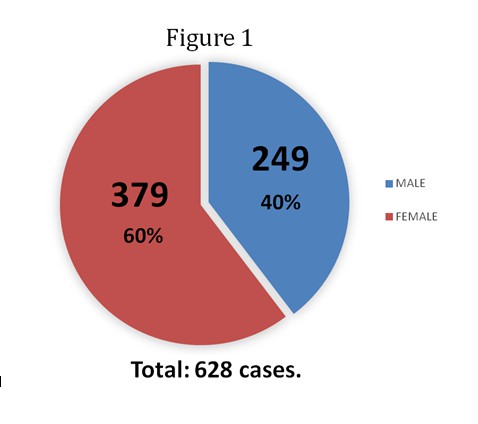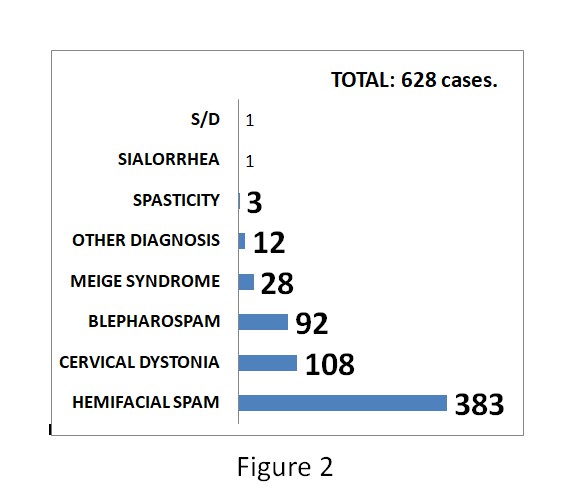Session Information
Date: Monday, September 23, 2019
Session Title: Clinical Trials, Pharmacology and Treatment
Session Time: 1:45pm-3:15pm
Location: Agora 3 West, Level 3
Objective: To update the experience with botulinum toxin type A therapy at the Unidad de Movimientos Involuntarios (UMI) of Instituto Nacional de Ciencias Neurologicas (INCN)-Lima, Peru, since the date was created until now.
Background: First report of Peruvian experience with botulinum toxin type A therapy is dated from 1998 (1), followed by a description of clinical and epidemiological aspects in 188 patients in 2000 (2), and its effectiveness in hemifacial spam in 44 patients (3).
Method: We reviewed our database patients since 1995 to July, 2018, which including gender, age, diagnosis, side affected, first injection date, doses and times of injection. All of patients signed an authorization where is explained clearly the diagnosis, the procedure and the effect of the injection, and an authorization to take a picture and record a video including the possibility to show the images in a medical forum.
Results: 628 patients were attended during this time, 60% were women and 40% were men (Figure 1). A total of 1547 injections were applied, at least two times in 155 of the patients (44%). Hemifacial spam was the more frequent diagnosis (383 cases), being a-30 to 59-year-old-woman with hemifacial spam the most frequent patient. Cervical dystonia was the second more frequent diagnosis (108 cases), 64% of them were men, in contrast with all of the reviewed series where cervical dystonia was more frequent in women. Blepharospam was the third (92 cases) and Meige syndrome was the fourth with 28 cases. Finally, we found a small group of 17 patients with spasticity, sialorrhea and other diagnosis (Figure 2).
Conclusion: Our unit is a referal center to the treatment with botulinum toxin A. In these 23 years we have treated successfully 628 patients with different movement disorders diagnosis, even though the expensive cost of the treatment, improving considerably the quality of life of our patients.
References: 1. Cosentino C, Torres L. Peruvian experience with botulinum toxin A in focal/segmental dystonia. Mov Disord 1998;13 (Supl 2): 228. 2. Torres L, Cosentino C, Zevallos D, Mendoza G. Espasmo hemifacial: Consideraciones clínico-epidemiologicas a proposito de 188 casos. Revista Peruana de Neurologia 2000;6:4-8. 3. Torres L, Cosentino C. Eficacia de la toxina botulinica en espasmo hemifacial. Diagnostico 1999; 38(4):182-184.
To cite this abstract in AMA style:
M. Velez, C. Cosentino, L. Torres. Botulinum toxin type A therapy in a movement disorders unit: a 23-year experience. [abstract]. Mov Disord. 2019; 34 (suppl 2). https://www.mdsabstracts.org/abstract/botulinum-toxin-type-a-therapy-in-a-movement-disorders-unit-a-23-year-experience/. Accessed December 16, 2025.« Back to 2019 International Congress
MDS Abstracts - https://www.mdsabstracts.org/abstract/botulinum-toxin-type-a-therapy-in-a-movement-disorders-unit-a-23-year-experience/


